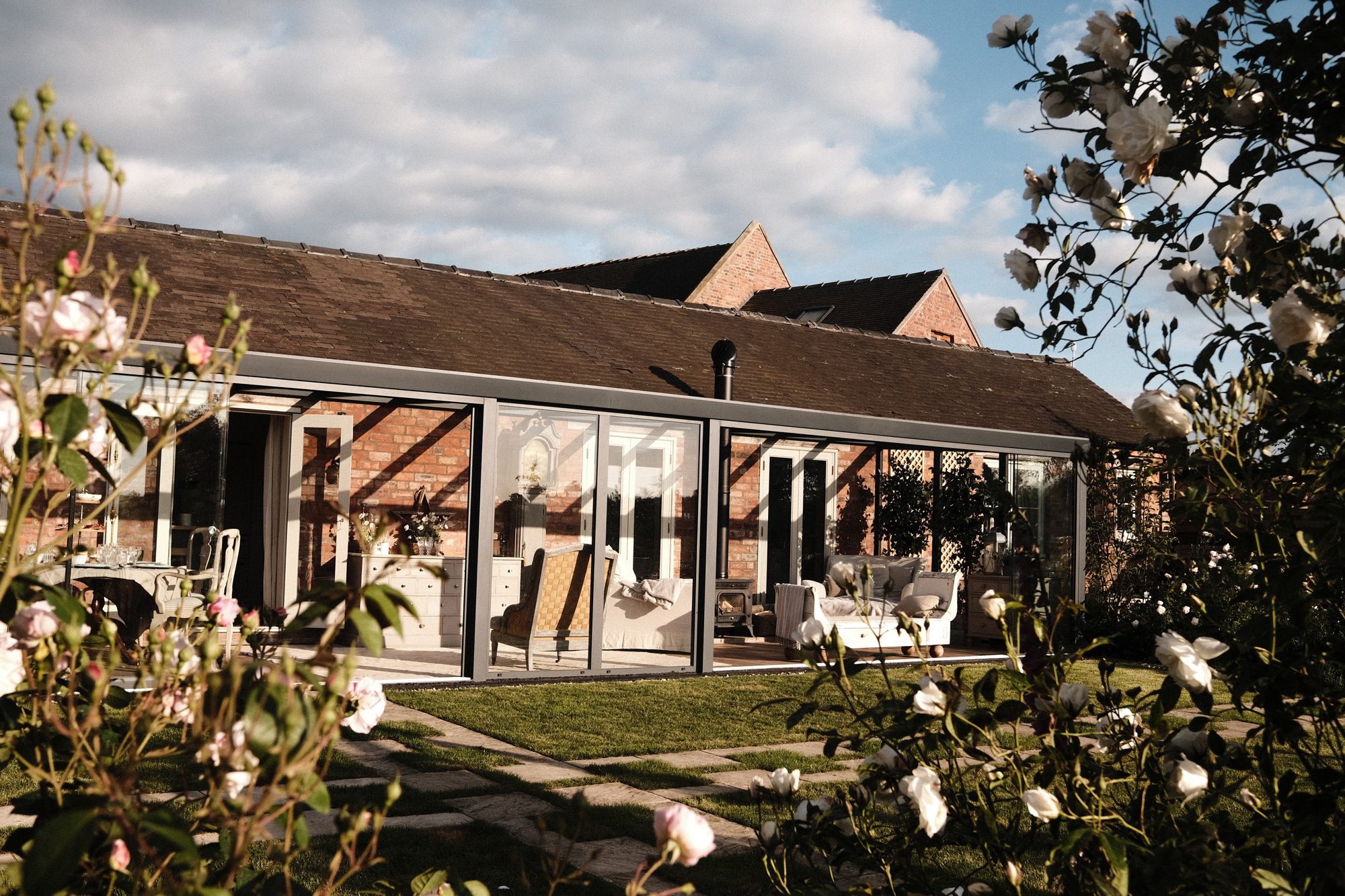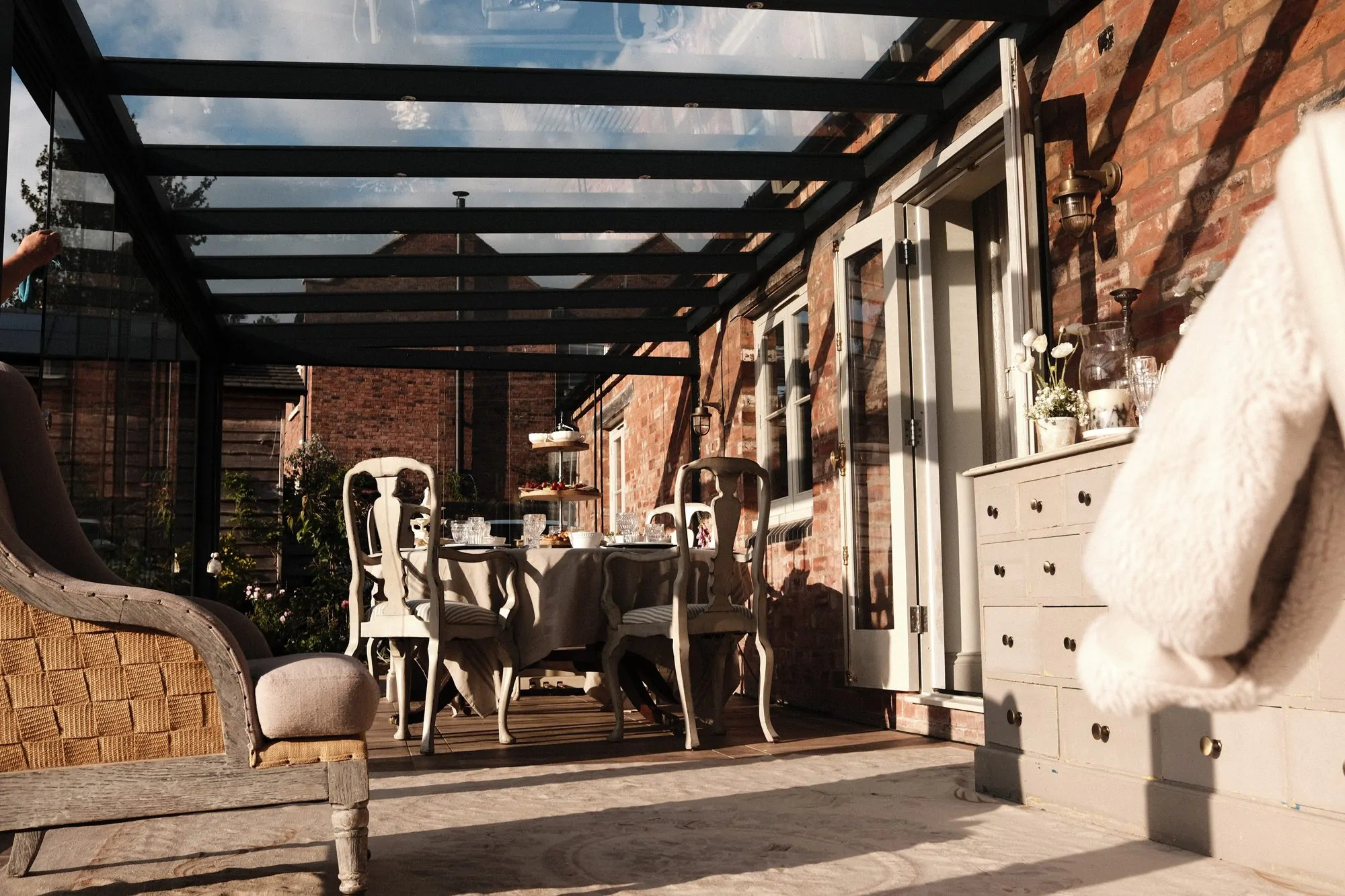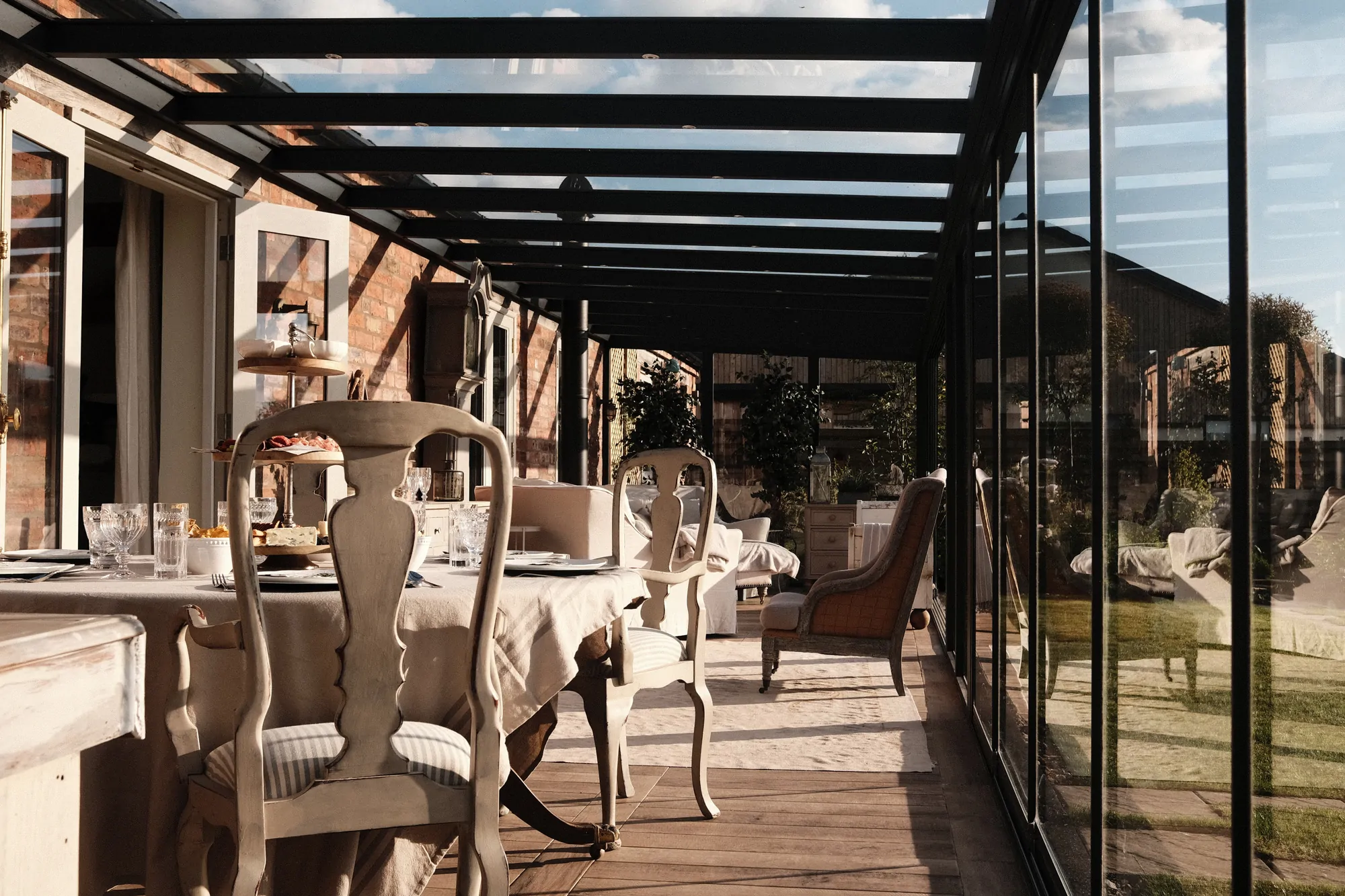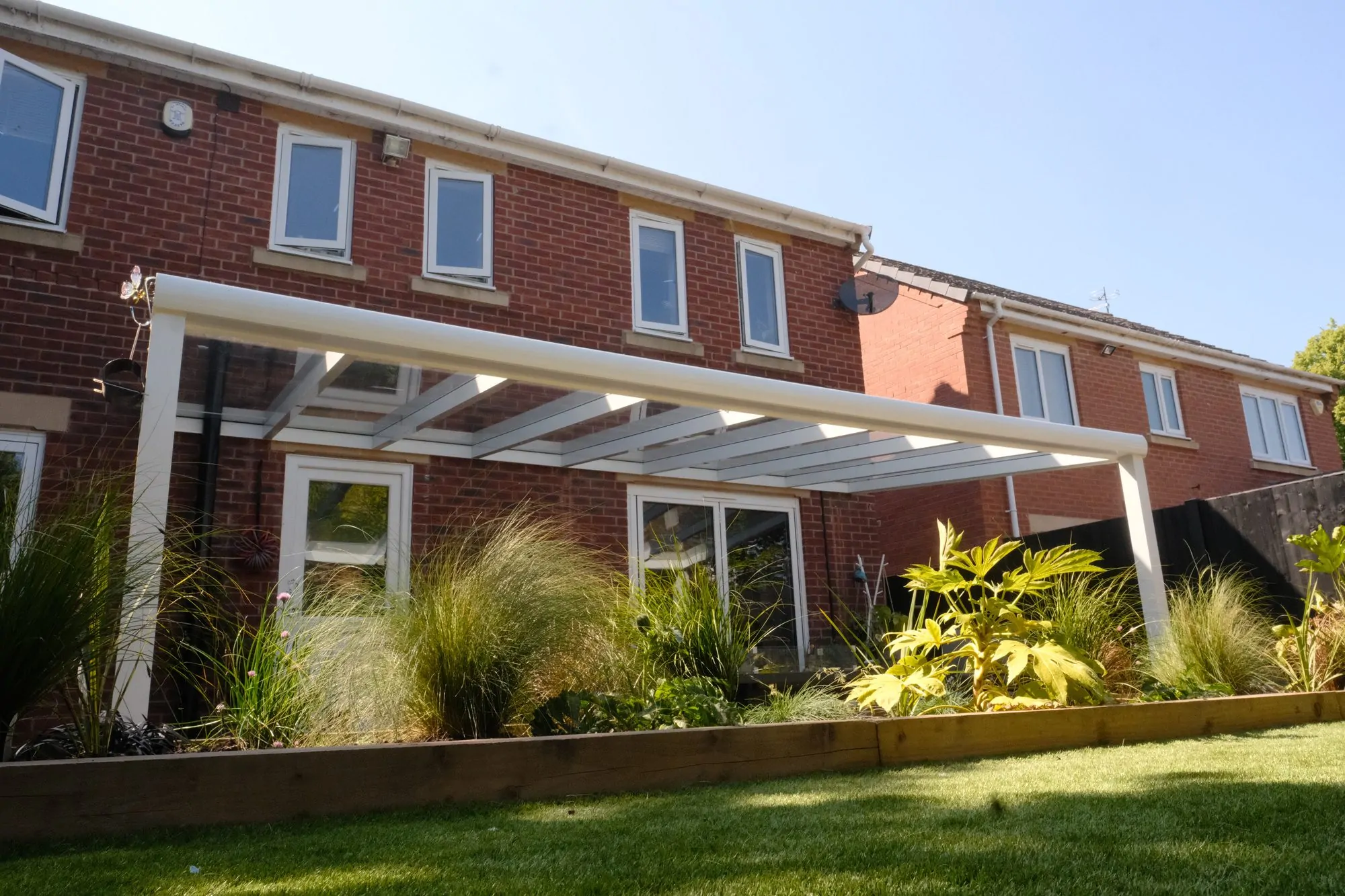When selecting the roofing for your veranda or glass room, glass remains the premium choice for those who prioritize high-end aesthetics, clarity, and a luxurious finish. While polycarbonate offers durability and cost-effectiveness, glass excels in providing a sleek, flawless view of your outdoor space, maximizing natural light, and delivering a superior, refined look. At Fleming Verandas, we use 8.8mm laminate safety glass in all our veranda roofs, which offers distinct advantages over traditional toughened glass.
Laminate glass is composed of two or more layers of glass that are bonded together by a thin interlayer, typically made of polyvinyl butyral (PVB). This interlayer holds the glass layers together even if the glass is broken, meaning that in the event of an impact, the glass remains intact rather than shattering into large, dangerous shards. This property makes laminate glass much safer and more durable than single-pane or toughened glass.
The 8.8mm laminate safety glass we use for veranda roofs is specifically designed for outdoor environments. It combines the transparency and elegance of glass with enhanced safety features, making it a popular choice for homeowners looking to create a sophisticated, light-filled outdoor living space without compromising on safety or durability. Additionally, laminate glass offers acoustic benefits, helping to reduce external noise, making your veranda a quieter, more peaceful space to relax in.
While toughened glass (also known as tempered glass) is another popular option for verandas and glass structures, laminate glass offers several key advantages that make it a superior choice for roofing applications.
- Enhanced safety: Toughened glass is known for its strength and ability to withstand impact, but when it breaks, it shatters into small, blunt pieces. This is a safety feature, but laminate glass goes a step further by holding the glass in place even after it’s cracked. The PVB interlayer in laminate glass ensures that broken glass stays adhered to the layer, reducing the risk of injury and preventing glass from falling into the veranda space below. This feature is especially important for overhead structures like veranda roofs, where safety is a primary concern.
- Better impact resistance: While toughened glass is four to five times stronger than regular annealed glass, laminate glass offers a different type of strength. The layered construction of laminate glass makes it much more resistant to penetration. Even if the outer layer cracks, the inner layers and interlayer remain intact, offering better protection against debris, falling branches, or other objects that might impact the glass. This is particularly useful in areas prone to severe weather, ensuring that your veranda roof remains functional and intact after storms or heavy winds.
- UV protection: One often-overlooked benefit of laminate glass is its ability to block harmful ultraviolet (UV) rays. The PVB interlayer in laminate glass acts as a barrier that filters out a significant portion of UV radiation, helping to protect your outdoor furniture, decking, and other materials from sun damage and fading. Toughened glass, on the other hand, does not typically offer this same level of UV protection.
- Noise reduction: Laminate glass is also superior when it comes to acoustic insulation. The interlayer helps to absorb sound vibrations, reducing noise from outside sources such as traffic or neighbours. This feature makes your veranda or glass room a more peaceful retreat. Toughened glass, while strong, doesn’t provide the same level of soundproofing due to its single-layer construction.
- Durability over time: Because laminate glass remains intact even after impact, it’s less likely to need replacement following damage. Toughened glass, while strong, must be replaced entirely if it breaks. Laminate glass, on the other hand, may only require repair or replacement of the outer layer, making it a more cost-effective solution in the long term.
In addition to these practical benefits, laminate glass also offers aesthetic flexibility. For customers looking for greater privacy without sacrificing natural light, we offer sand-blasted laminate glass. This option features a frosted or etched surface that diffuses light while obscuring visibility, allowing you to enjoy your outdoor space without the prying eyes of neighbours. The sand-blasted finish still maintains the same strength and safety features of standard laminate glass, ensuring that your veranda or glass room is both secure and private.
One of the considerations when choosing glass is maintenance. While glass roofs require regular cleaning to maintain their pristine clarity, laminate glass is easier to clean than polycarbonate and tends to maintain its appearance for longer. The smooth surface of glass is less prone to scratching and weathering, and with proper care, laminate glass can retain its clear, elegant look for many years. It is a long-lasting, low-maintenance material that enhances the visual appeal of your outdoor living space.
Overall, laminate glass offers a host of advantages over toughened glass, making it the superior choice for veranda and glass room roofs. With enhanced safety, better impact resistance, UV protection, noise reduction, and long-term durability, it provides the perfect blend of style and functionality. While it requires regular cleaning, its ability to maintain a flawless, elegant appearance ensures that your outdoor space will look stunning for years to come. Whether you’re looking for a clear roof that maximizes light or a sand-blasted option for added privacy, laminate glass is the premium solution for transforming your outdoor area into a luxurious and safe living space.
Looking for some inspiration? Click here to see some of our recent work!
Interested in examples of our verandas and glass rooms? See below a selection of photos from some of our recent projects!
Here’s a few image from different projects that showcase what we’ve discussed:

Got questions? Here are some of our most common!
What is the main difference between laminate glass and toughened glass?
The main difference lies in their structure and safety features. Laminate glass consists of two or more layers of glass bonded together with an interlayer (usually polyvinyl butyral, or PVB), which holds the glass together even if it breaks. In contrast, toughened glass is a single pane of glass that has been heat-treated to be stronger and, when broken, shatters into small, blunt pieces to reduce the risk of injury.
Which type of glass is safer: laminate or toughened?
Laminate glass is generally considered safer because it remains intact when broken, thanks to the interlayer that holds the shattered pieces together. This prevents glass from falling and reduces the risk of injury. Toughened glass, while strong, breaks into small, blunt pieces when shattered, which also reduces injury but doesn’t prevent glass from falling.
Which glass offers better impact resistance: laminate or toughened?
Both are strong, but in different ways. Toughened glass is about four to five times stronger than regular glass and is very resistant to impacts. However, laminate glass has superior penetration resistance due to its layered structure. Even if the outer layer of laminate glass breaks, the interlayer holds it together, offering better protection against impacts over time.
Does laminate glass block UV rays?
Yes, laminate glass provides excellent UV protection because the PVB interlayer blocks a significant portion of harmful ultraviolet rays. This feature helps protect furniture, flooring, and other materials from sun damage and fading. Toughened glass, by contrast, does not offer the same level of UV protection unless specifically treated.
Which glass is better for reducing noise: laminate or toughened?
Laminate glass is better for noise reduction. The PVB interlayer between the glass panes helps absorb sound vibrations, making it a more effective barrier against external noise. Toughened glass, with its single-layer construction, does not offer the same level of soundproofing as laminate glass.
What happens when toughened glass breaks?
When toughened glass breaks, it shatters into small, blunt pieces. These fragments are less likely to cause serious injury than traditional glass, but the entire pane needs to be replaced once it shatters. In comparison, laminate glass will crack but remain intact due to the interlayer, which often allows for partial repairs instead of full replacement.
Which type of glass lasts longer in outdoor environments?
Laminate glass tends to last longer in outdoor environments, especially because of its layered structure that offers more durability and resistance to damage. Even after impact, laminate glass can remain functional. Toughened glass is durable but needs complete replacement if it breaks, which may make it less cost-effective over time.
Can laminate and toughened glass be used together in the same structure?
Yes, it’s common to use laminate glass for areas where safety and noise reduction are a priority, such as roofs, and toughened glass for areas like sliding doors or walls where strength and impact resistance are crucial. This combination allows you to take advantage of the benefits of both types of glass.












